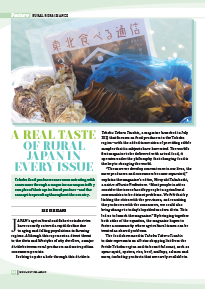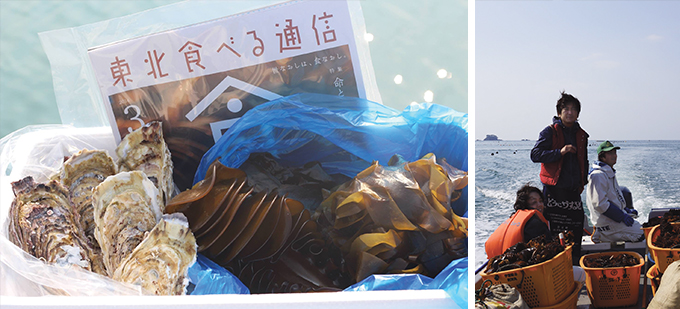Home > Highlighting JAPAN >Highlighting Japan June 2015>Rural Renaissance
Highlighting JAPAN

Rural Renaissance
A Real Taste of Rural Japan in Every Issue
Tohoku food producers are communicating with consumers through a magazine accompanied by samples of their agricultural produce—and the concept is spreading throughout the country.

Japan’s agricultural and fisheries industries have recently entered a rapid decline due to aging and falling populations in farming regions. Although this represents a direct threat to the diets and lifestyles of city dwellers, a major divide between rural producers and metropolitan consumers persists.
Seeking to poke a hole through this divide is Tohoku Taberu Tsushin, a magazine launched in July 2013 that focuses on food producers in the Tohoku region—with the added innovation of providing edible samples that its subjects have harvested. The world’s first magazine to be delivered with actual food, it operates under the philosophy that changing food is the key to changing the world.
“The more we develop convenience in our lives, the more producers and consumers become separated,” explains the magazine’s editor, Hiroyuki Takahashi, a native of Iwate Prefecture. “Most people in cities consider the issues faced by people in agricultural communities to be distant problems. We felt that by linking the cities with the provinces, and reuniting the producers with the consumers, we could also bring change to today’s lopsided modern diets. This led us to launch the magazine.” By bringing together both sides of the equation, the magazine hopes to foster a community where agricultural issues can be treated as shared problems.
The food showcased in Tohoku Taberu Tsushin to date represents an all-star shopping list from the fertile Tohoku region and its bountiful coast, such as spear squid, oysters, rice, beef, scallops, salmon and more, including products that are rarely available in big cities. The March 2014 issue was delivered with a two-meter cut of raw seaweed from Minamisanriku in Miyagi Prefecture, bringing a major response from readers. Rarely available for sale in unsalted form, this fresh seaweed offers a refreshing ocean scent and a rich flavor that can be enjoyed simply by dipping it in hot water.
The magazine’s finely crafted text and images have piqued the interest of readers, who get glimpses into the backstories of food producers and the passion they put into their work, shrinking the gap between reader and maker. Being able to taste the hard-won fruits of the producers’ labors brings the two even closer.
Tohoku Taberu Tsushin is currently limited to fifteen hundred subscribers, a number deliberately kept low to foster a community small enough that its members can recognize one another’s faces. Seventy percent are people between their thirties and fifties living in the Tokyo metropolitan area, and the majority learned of the magazine by word of mouth and found the philosophy resonated with them.
“Until now, producers didn’t have a chance to learn about the kinds of people who were eating their food, or how they ate it,” observes Masayuki Abe, who is in charge of the production-side system, assisting with packaging and arranging events connecting readers with producers. “Tohoku Taberu Tsushin has an online community where readers can post recipes and photos of the food they make, fostering communication between both parties. This has led to producers moving beyond the traditional system of simply shipping out goods. They’re actively putting information about their products online and selling them over the Internet. They’ve embraced the format and are using it to make their presence known. Meanwhile, many readers have taken it upon themselves to visit the producing regions, hold workshops, and actively promote the magazine’s mission.”
Projects based on Tohoku Taberu Tsushin are already rippling through Japan. As of May 2015, similar magazines have been published in twelve regions, including Shikoku, Hokkaido and Kanagawa Prefecture. The editorial club at a local high school produces the Fukushima Prefecture edition, including doing the interviews and writing the content. Takahashi’s dream is to have the Taberu Tsushin concept reach one hundred areas of Japan within the next three years.
As products created through the passion and effort of local producers make their way toward the city, readers eagerly await their arrival. By forming links between farmers and urban communities, food becomes a means of energizing the nation’s provincial regions, and similar projects may soon be seen all over Japan.
© 2009 Cabinet Office, Government of Japan






